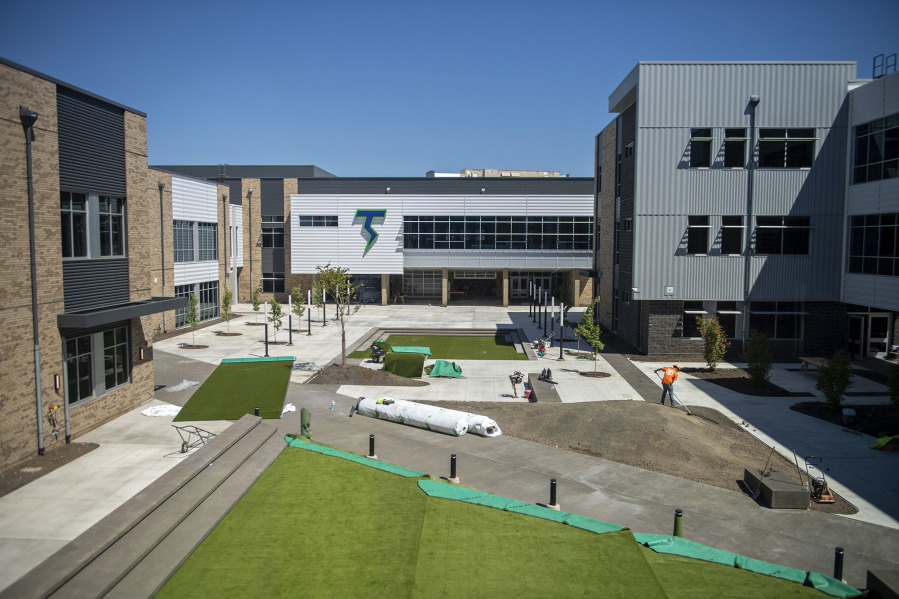SEATTLE — The Wahkiakum School District’s lawsuit against Washington state could mean a massive shift in the way school construction is funded, or no change at all. A state Supreme Court hearing on Tuesday offered few clues as to how this might shake out.
The school district, which hasn’t passed a bond in 22 years, sued the state last year claiming that reliance on local taxpayers to fund basic construction costs is a violation of the state’s Constitution. The state maintains that funding construction is not an obligation.
But at the first and only hearing in the case, attorneys for both sides didn’t get more than a few words into their prepared statements before justices launched into sharp lines of inquiry.
While they questioned whether the state had a constitutional responsibility for funding capital costs, a few justices appeared to acknowledge the inequities faced by districts like Wahkiakum.
“My impression is they’ve reached a fork in the road,” Tom Ahearne, the school district’s attorney, said just after the hearing concluded.
Tiny, property-poor districts like Wahkiakum have few options for funding fixes to their buildings if a bond does not pass. They do not qualify for the state’s largest school construction aid grant, and have to look for other sources of money that do not always cover the cost of necessary school maintenance.
In the absence of funding, Wahkiakum has not been able to renovate its aging facilities. Rain leaks from ceilings, and bathrooms flood daily. There is little lab equipment for students to conduct science experiments.
The district’s case hinges on Article 9, Section 1 of the Washington State Constitution that was central to another recent school funding case, McCleary v. Washington. On the plaintiff’s side of the courtroom, the clause was displayed on a poster board in large text:
“It is the paramount duty of the state to make ample provision for the education of all children residing within its borders …”
In the McCleary case, the court ruled that the state must cover basic operating costs; local levies had been filling in where the state was obligated to fund. The Legislature was ordered to craft a fix, resulting in the system we have today: The state funds essential operating expenses, while local taxes can fund extra programs and activities.
Wahkiakum wants the court to apply this same logic to school construction, arguing that the basic funding of a school building is part of the “paramount duty.” Justices asked the most questions about this premise.
The state’s attorney, Lauryn Fraas, argued that the 2017 McCleary court order explicitly excluded school construction costs. School bonds are also mentioned in the constitution as a way to raise funds for construction. She also pointed to state grant programs that assist with school construction costs. She declined to comment on the case.
“The constitution treats construction costs differently from everyday costs. And McCleary itself treated them differently … and now you’re asking us to treat them the same,” said Justice Sheryl Gordon McCloud.
Ahearne, who was the lead plaintiff’s attorney on the McCleary case, agreed that McCleary was about operating costs — it wasn’t a case about capital construction. Just as school bonds are mentioned in the constitution, so is the ability to pass levies for funding.
Referring back to the constitutional clause, Ahearne said that if “paramount” means above everything else, it supersedes other language. “It governs everything else.”
Toward the end of the hearing, during the state’s portion of time, justices also challenged the state’s position that it has zero obligation for funding construction.
“The court held (in the McCleary order) … that full state funding of school capital costs is not part of the program of this education constitutionally required by Article 9 section 1,” said Fraas.
Justice Susan Owens cut in quickly.
“I have it in front of me. I’m not sure that’s binding or precedent that has to be adhered to. It says the state doesn’t have to do full funding. But that doesn’t mean you can’t do some funding for buildings,” she said. “If you don’t have a chemistry lab or a biology lab, you can’t really learn science, biology and chemistry. Don’t you need a lab to work in? I did when I was in high school.”
The case could shake out in three ways, according to Ahearne. First, the court could side with the state, which keeps things status quo. Second, the court could side with Wahkiakum and send the case back to the lower courts, which would determine how much the district is owed in funding. This option would then open the door for other school districts to sue on the same basis.
The third option is the most desirable for the district. The court would hold onto the case, avoiding a debate in the lower courts, and ask the state to come up with a solution for funding basic construction costs.
“Who knows what’s going to happen? Our fate is in the hands of nine people,” said Brent Freeman, the Wahkiakum superintendent.



